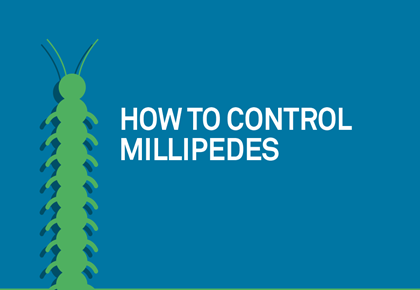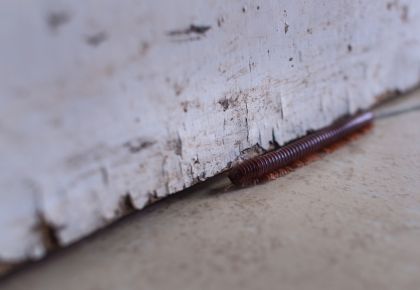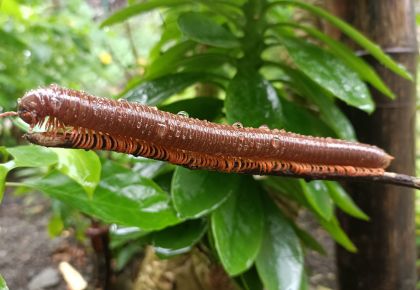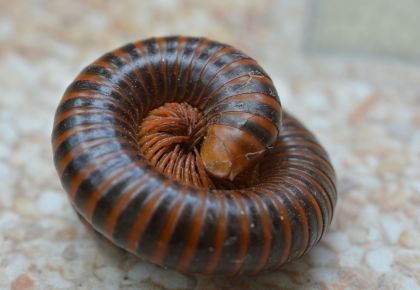How to Get Rid of Millipedes and How to Prevent Their Invasion
 Ah, Florida nights. Warm ocean breezes. Near perfect temperatures. Enjoying your community with family, neighbors...and a disgusting mass of undulating insects climbing up the side of your building? Yes, with spring and fall come millipede season. These arthropods are a perennial pest that bring a huge yuck factor and significant inconvenience. And while they’re not the worst pest in the pantheon of creepy crawlies, they’re definitely not something you want populating your sidewalks, yards and swimming pools. What is the fastest way to get rid of millipedes? Remember these solutions – because they have enough “legs” to carry you through all of this pest-ridden season. Check out our 7 ways to get rid of millipedes!
Ah, Florida nights. Warm ocean breezes. Near perfect temperatures. Enjoying your community with family, neighbors...and a disgusting mass of undulating insects climbing up the side of your building? Yes, with spring and fall come millipede season. These arthropods are a perennial pest that bring a huge yuck factor and significant inconvenience. And while they’re not the worst pest in the pantheon of creepy crawlies, they’re definitely not something you want populating your sidewalks, yards and swimming pools. What is the fastest way to get rid of millipedes? Remember these solutions – because they have enough “legs” to carry you through all of this pest-ridden season. Check out our 7 ways to get rid of millipedes!
1. Millipedes are not dangerous.
Yucky, yes. Disgusting, maybe. Inconvenient, definitely. But, unlike their cousins the centipedes, millipedes have no bite and will not harm you. In fact, if you disturb one, it’ll probably just curl up into a ball. You can tell them from their dangerous counterparts by their cylindrical body, undulating movement and their length – about a 1/2 inch to 6 1/2 inches. Oh, and though the metric system tells us that a millipede should have 1000 legs, they really only have between 80 and 100.
2. Keep them out by sealing cracks.
 If you find yourself asking, "Why are millipedes in my house in Florida?" Anything with 100 legs has no place inside your home! So to keep them in the great outdoors and prevent a millipede infestation, take this opportunity to seal cracks and openings on the exterior of your home. Pay attention to foundations, windows, doors, grates and vents – if gaps exist in these areas, you might as well put out a millipede-sized welcome mat in these spots.
If you find yourself asking, "Why are millipedes in my house in Florida?" Anything with 100 legs has no place inside your home! So to keep them in the great outdoors and prevent a millipede infestation, take this opportunity to seal cracks and openings on the exterior of your home. Pay attention to foundations, windows, doors, grates and vents – if gaps exist in these areas, you might as well put out a millipede-sized welcome mat in these spots.
3. Watch for moist areas.
Does your community have soggy areas with poor drainage? Are there places where the ground stays damp, or wet spots that never really dry? These are the places where millipedes thrive. Eliminate these areas and you’ll be taking away the breeding ground for these pesky pests.
4. Take away rotting leaves and wood.
 Millipedes feed on rotting plant matter and wood. It’s their favorite meal. So if you suddenly have millipedes in your house, try taking away their food source, you just might remove your millipede infestation problem, too. When you’re searching out these damp piles of millipede chow, pay specific attention to those areas that are located close to building foundations – these are prime entry points for your 100-legged “friends.”
Millipedes feed on rotting plant matter and wood. It’s their favorite meal. So if you suddenly have millipedes in your house, try taking away their food source, you just might remove your millipede infestation problem, too. When you’re searching out these damp piles of millipede chow, pay specific attention to those areas that are located close to building foundations – these are prime entry points for your 100-legged “friends.”
5. Keep subfloor spaces and garages dry.
Remember, dampness is a millipede magnet. And subfloors and garages, especially here in Florida, tend to collect moisture and attract pests. Find the sources of your wet spots and eliminate them. It’s a great way to eliminate your millipede problem before it has the chance to rear its ugly head.
6. Don’t over-mulch or over-water.
Moisture and decaying plant matter are heaven for millipedes. They thrive in these conditions – so eliminate them right away. It may be tempting to be generous with the mulch and water, but remember that too much of a good thing is not only bad for your landscaping, but it could also create a big millipede problem.
7. Establish a perimeter.
 Your pest control professional is your best friend this time of year. Call them out and have them establish a 10- to 15-foot perimeter around buildings, exterior garage walls and windows. That way, if all of your other measures fail, the millipede march will never make it inside your home.
Your pest control professional is your best friend this time of year. Call them out and have them establish a 10- to 15-foot perimeter around buildings, exterior garage walls and windows. That way, if all of your other measures fail, the millipede march will never make it inside your home.
Remember, millipedes aren’t dangerous, but they tend to collect en masse and create an unsightly mess. Keep your community clean and pest-free by following these simple steps.
For more information on controlling millipede infestations, contact FirstService Residential.